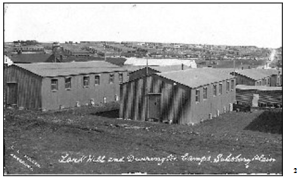Monday, December 21, 1914
In Camp, West Down South, Salisbury Plains
The Battalion War Diarist wrote for this day: “Battn. Moves to Lark Hill, Salisbury Plains.” [1]

THIS DAY IN RMR HISTORY: “The type of hut was one storey, wooden frame on brick piers, with corrugated iron roof and walls lined with heavy paper, each hut accommodating forty men. The floor area was about 1200 square feet. There were six windows on each side, and a door at each end. Furnishings included trestle tables and beds, long wooden forms, cupboards and crockery, two oil lamps and a stove of the Quebec heater type. Bath houses, with showers and tubs were still uncompleted in mid-January, and a scheme for drying uniforms submitted by a laundry firm was approved but not developed, so wet clothing dried on the wearer.
As huts became available for occupation units were moved in. On 9th November the 4th Canadian Infantry Brigade moved from Pond Farm to huts erected under War Office arrangements at Sling Plantation, northeast of Bulford; the Canadian Engineers moved into Lark Hill huts on the 14th November and were followed by the 3rd and 2nd Brigades, whose moves were completed by 18th December.” [3]
“Bad weather continued during December and life in the flooded tents became miserable in the extreme. As one letter writer feelingly put it, “Things over here are not pretty wet, they are most blighted soaking.” He might have added comment on the penetrating quality of the prevailing wind, which another writer observed, made it “too cold to bathe outside,” a disadvantage as it was also “too crowded to bathe in the tents.” Such conditions, which interfered with all training and rendered outdoor recreation impossible, seriously endangered the health of the troops and eventually a move was made from the tents at West Down South to huts at Lark Hill. The 14th Battalion moved on December 21st, and no one was sorry to leave the soaking tents behind. The huts were not unduly commodious, but they were rain-proof and provided the men when off duty with shelter and a spot where they could partly dry their saturated clothes.” [4]
[1] War Diary, 14th Canadian Battalion, The Royal Montreal Regiment, Dec 21, 1914. Library and Archives Canada, Ottawa, http://data2.collectionscanada.ca/e/e044/e001089681.jpg
[2] http://www.kiplingsociety.co.uk/pix/canadian_lines.jpg
[3] Col. A.F. Duguid, “Official History of the Canadian Forces in The Great War 1914-1919, Vol. 1, Part 1, King’s Printer, Ottawa, 1938, pp. 130-131.
[4] R.C. Featherstonhaugh, The Royal Montreal Regiment 14th Battalion C.E.F. 1914-1925, Montreal, The Gazette, Printing Co., Ltd., 1927, pg. 19.

